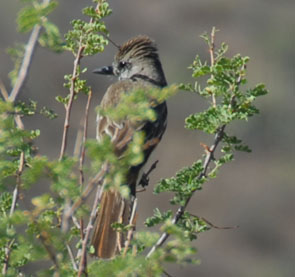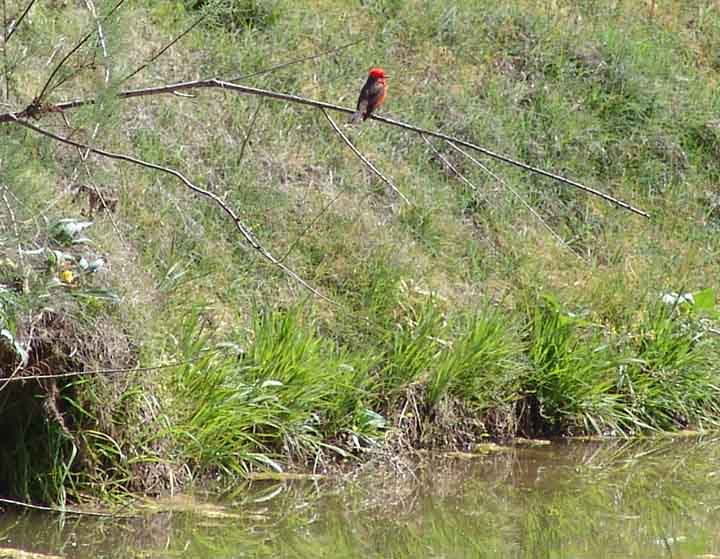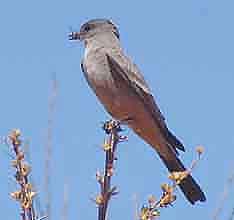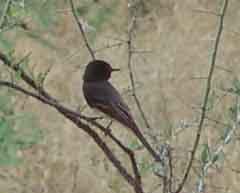 ..
.. ..
..
Flycatchers, Kingbirds, Phoebes, Peewees
Note: references will be found on the main Birds page.
Most of these birds "sit quietly [on tree or shrub branches], and sally forth to snap up insects" (Peterson 1990, p. 230). Most have comparatively "drab plumage and short, rather broad-based, flattened bills" (Sibley 2000, p. 320), and all of them feed mainly on insects which they capture in buoyant, agile flight (making quick turns and abrupt movements).
Ash-throated Flycatcher (Myiarchus cinerascens)

This beautiful young Ash-throated above was busy catching bees beside a small terrace drinker in lower Hot Springs Canyon on June 12, 2008. Its beauty was such that we include several images of it below. (Click on each image for a higher-quality view.)
 .
. .
. .
.
Ash-throated Flycatchers are common in our area, and at least some of them remain here year-round. They are distinguished by their often bushy, brownish crest, pale whitish throat, a very pale yellowish tinge to their lower bellies, and a rufous tail. (You can see these features better in the enlargements.) These birds make a simple "pweet" call, repeated.


Brown-crested Flycatcher (Myiarchus tyrannulus)

Also called the Mexican Crested Flycatcher, this large Flycatcher has a relatively large bill, a large brown crest and gray-brown throat and breast, yellow belly, and tail feathers "edged with reddish brown down to tip" (Stokes, Donald & Lillian, p. 306). It breeds in our area and winters in Mexico.
Western Kingbird (Tyrannus verticalis)



Distributed throughout the continental U.S. West during the summer months, this large and handsome Flycatcher has a yellowish belly and gray head, but distinct from other Kingbirds, its "black tail has a narrow white edging on each side" (Peterson 1990, p. 232). (Some of this can be seen in the images above.) They are common in both gallery forest and uplands in our area before they migrate in the fall. (The images above were taken near the Cascabel Community Garden in September of 2007, where they had likely been feasting on the dense crop of also-ravenous grasshoppers infesting the grounds below. (Click on each image to enlarge it.)
The white edging of an otherwise blackish tail is noticeably visible in the center image below. The birds captured in these images were photographed at the Red Tank in September 2006, where they were luxuriating in a strong hatching of grasshoppers and other insects. Kingbirds "are specialized with long, pointed wings for aerial hawking" (Sibley 2001, p. 387), and are very acrobatic insect-hunters, who remain on perch until they sight an insect, then sally out to grab it in the air.
Note in the image above right that two birds are sharing the same perch tree. A number of Western Kingbirds were flying about in this area, and some displayed aggressiveness toward competitors who came too close. This is typical -- Kingbirds are so named to mark their aggressive behavior, and we have seen them mercilessly harrassing Red Tail Hawks in Hot Springs Canyon. Sibley (2001, p. 391) observes that "A kingbird will defend its territory and nest against all predators, even to the point of 'riding' the back of a flying hawk or crow, all the time pecking the back of the head."
This bird below, seen perched in lower Hot Springs Canyon early morning May 30, 2008, also illustrates the white tail-edging characteristic of the species.


Below, a solitary bird photographed in September 2004 in Hot Springs Canyon. This image provides a good silhouette of typical perch, if little else.
(Click on the image for a close-up view.)

The Western Kingbird's song is very distinctive -- one expert on birdsong describes it as the sound of "a cassette tape running rapidly backwards." It winters south as far as Costa Rica.
Phoebes & Vermilion Flycatcher
An exception to the generally rather drab coloring of flycatchers, the Vermilion Flycatcher has a "flaming vermilion" coloring in the male (Peterson 1990, p. 230). The female is much drabber, and might be confused with Say's Phoebe (see below). While Peterson (map 251 shows them resident year-round in our area, they leave our part of the San Pedro River Valley in the fall and return in the spring. We see them mainly in the forest gallery of the River, but they also appear in Hot Springs Canyon.

This range of this bird extends from our area all the way south to Argentina. This one below was hanging out beside a shaded pool of water in Lower Hot Springs Canyon in May of 2006, perching on limbs and then swooping down to catch insects in or near the poolside grasses. (Click on each image to enlarge it.)
Below, June 11, 2009, San Pedro River near Teran Wash confluence. Maximum (X 10) zoom.

Below, this female was photographed May 6, 2006 near the confluence of Hot Springs Canyon with the San Pedro River. The streaked gray breast and the pinkish color near the vent are typical for this bird.

Say's Phoebe
(Click on each of the images below to enlarge it.)
 .....
..... .....
.....
 .....
.....
Say's Phoebe is gray-brown in overall color, but has a black tail and a pale-rust belly. It is about 7-8" in length. Say's Phoebes are found in our area the year around, but probably different birds are seen seasonally, since they do move southward in winter. The two birds seen in these images were perching, then flying out to catch insects, and were busy feeding their young in April 2005. See the black tail in the image below, as the bird flies from its perch:

Black Phoebe (Sayornis nigricans)
The two images below left were taken in May 2004, that on the right in May 2006, all three near the San Pedro River at Teran Wash. The Black Phoebe lives in our area year-round, usually staying near water. The white belly and all-dark upper body are characteristic. (Click on each image to enlarge it.)
 ..
.. ..
..
We think this bird (below), sighted in April 2000 just below the Yellow Cliffs of Hot Springs Canyon, was a Black Phoebe. It was running about the rocks at streamside, and dipping its tail repeatedly (see Sibley 2000 p. 330). The poor quality of the video camera precludes clearer identification.
 ..
..
Empidonax Flycatchers
These are small, drab flycatchers who "share the characters of white eye-rings and two pale wing bars" (Peterson 1990, p. 238). They are so similar in appearance that they can be distinguished best by voice differences. They are mostly found in woodland or brushy locations and mainly near water -- the one below was resting in the cool shade of Sierra Blanca Spring on September 9, 2004. They are strictly summer visitors to our area (some breed as far north as the Canadian arctic, and some of ours breed in our Canadian-zone Sky Islands).
(Click on the image for a close-up view.)

Among these Empidonax Flycatchers are an Endangered Species, the Southwestern Willow Flycatcher (Empidonax traillii extimus). While we currently have no photographs of this bird from our land (it is very difficult to distinguish from others of this genus by sight), the USGS SW BioSci Center at Northern Arizona University has this excellent website: Southwestern Willow Flycatcher-- which provides much detail on identification, distribution, bird behavior, including the bird songs that best distinguish them, etc.
Return to Birds




